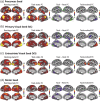Task-evoked functional connectivity does not explain functional connectivity differences between rest and task conditions
- PMID: 30144210
- PMCID: PMC6397020
- DOI: 10.1002/hbm.24335
Task-evoked functional connectivity does not explain functional connectivity differences between rest and task conditions
Abstract
During complex tasks, patterns of functional connectivity differ from those in the resting state. However, what accounts for such differences remains unclear. Brain activity during a task reflects an unknown mixture of spontaneous and task-evoked activities. The difference in functional connectivity between a task state and the resting state may reflect not only task-evoked functional connectivity, but also changes in spontaneously emerging networks. Here, we characterized the differences in apparent functional connectivity between the resting state and when human subjects were watching a naturalistic movie. Such differences were marginally explained by the task-evoked functional connectivity involved in processing the movie content. Instead, they were mostly attributable to changes in spontaneous networks driven by ongoing activity during the task. The execution of the task reduced the correlations in ongoing activity among different cortical networks, especially between the visual and non-visual sensory or motor cortices. Our results suggest that task-evoked activity is not independent from spontaneous activity, and that engaging in a task may suppress spontaneous activity and its inter-regional correlation.
Keywords: natural vision; spontaneous activity; task evoked functional connectivity; task-rest interaction.
© 2018 Wiley Periodicals, Inc.
Figures



References
-
- Arfanakis, K. , Cordes, D. , Haughton, V. M. , Moritz, C. H. , Quigley, M. A. , & Meyerand, M. E. (2000). Combining independent component analysis and correlation analysis to probe interregional connectivity in fMRI task activation datasets. Magnetic Resonance Imaging, 18, 921–930. - PubMed
-
- Arieli, A. , Sterkin, A. , Grinvald, A. , & Aertsen, A. (1996). Dynamics of ongoing activity: Explanation of the large variability in evoked cortical responses. Science, 273, 1868–1871. - PubMed
Publication types
MeSH terms
Grants and funding
LinkOut - more resources
Full Text Sources
Other Literature Sources

